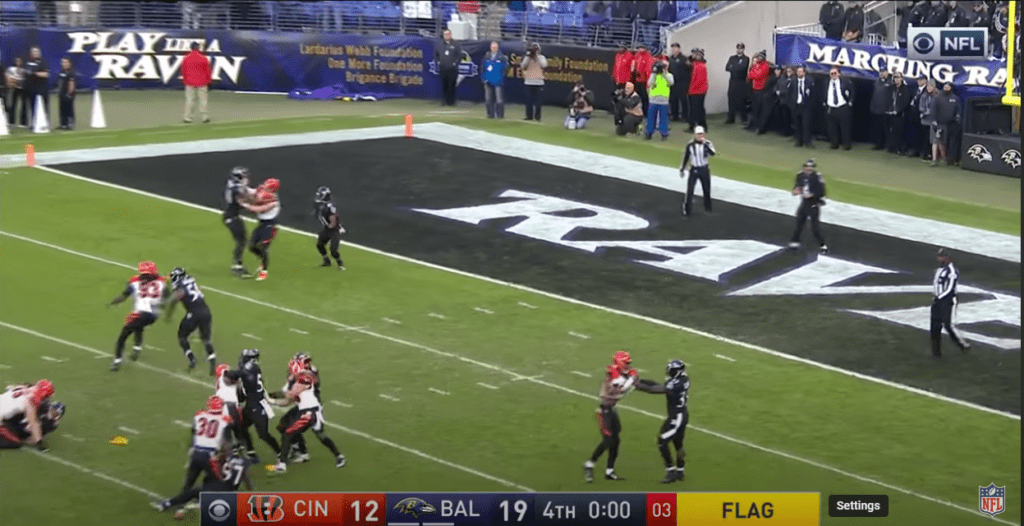A defensive pass inference happens with no time on the clock – and the offense gets another play. An offensive holding occurs on the last play, and the game is over.
Can a football game end on a penalty? Yes. If the time expires and the penalty is on the offense, the defense can accept the penalty and end the game. However, if the penalty is on the defense, the offense can accept and extend the game for one more play.
What about special teams? This rule is fascinating. Watch the video below and see for yourself!
Can A Football Game End On A Penalty?
In short, the football game can end on a penalty if the penalty is on the offense. If it’s on the defense, the offense will have an opportunity for one untimed down.
Watch here on YouTube: https://www.youtube.com/watch?v=baCeMpAZIgI&pp=ygUTcmF2ZW5zIGJlbmdhbHMgcHVudA%3D%3D
In the video above, we look at an interesting punting play from the Week 12 (2017) game between Baltimore Ravens and Cincinnati Bengals, where the game would end on a penalty.
Baltimore is backed up to their 23-yard line and is forced to punt. Up by 7 with 11 seconds left, Coach Harbaugh, a former special teams coach, calls an unusual play.
He keeps all ten players in a tight punt formation and instructs them to hold. He then tells his punter to wait as long as possible and take safety.
The holding draws numerous flags from the referees, and the punter steps out of the back of the end zone.
The game ends on this call because the punting team is technically the offense. They can run the clock out, then the game automatically ends on the offense.
Can a Football Game End On a Penalty?
Let’s dive into the ruling.
In a 19-12 ball game with 11 seconds left, Baltimore was backed up in its zone and forced to punt. Instead of risking a return, Coach Harbaugh called for all of his players to hold the opposing team until the clock ran out. After the play ended, the game ended as well.
A few questions that need answers:
- Why did the game end on a penalty?
- How Come Harbaugh told all of his players to hold and have his punter wait to take a safety?
- Why didn’t Cincinnati get the ball?

The rule in the NFL (and college and high school) states that a play can NOT end on a defensive penalty. However, the game can end on an offensive penalty.
The Baltimore Ravens are backed up on their goal line in this situation. If they decide to kick the football, they risk a potential block, resulting in a touchdown (especially when they’re up 7 points).
Coach Harbaugh tells all of his players to hold as long as possible while the punter runs around until the time expires.
There are multiple flags on the play (if the referee had more flags/hats, I’m sure they would have thrown them as well).
As noted above, the game can’t end on a defensive penalty.
A perfect example of a defensive penalty in this situation would be if the team throws a Hail Mary, and the defense gets called for holding or pass interference. This would result in one untimed play and not end on a penalty.
Increase Your Football IQ
Why spend hours on Google and YouTube trying to learn football yourself? We’ve created a simple guide to help make you the smartest person in the room.
Defensive Penalty
For example, if the defense, frustrated that they were being held, decided to throw a punch and warrant a 15-yard personal foul, it would allow the offense to accept or decline the penalty (they would have declined it).
This is the prime example of why the game can’t end in a defensive penalty – it’s always in favor of the offense.
The game ends because there are no “untimed downs” in the defense’s favor. The game is officially over once the clock hits 0, regardless of the offensive penalties. It’s a small loophole in the rulebook, but it makes sense from a scoring standpoint.
Holding To Take A Safety
Why did Harbaugh tell all of his players to hold and have his punter wait to take a safety?
There are a few reasons why he wants his players to hold and take a safety:
- The holding restricts players from getting to the punter
- The safety grants 2 points to the opposing team
If you want to waste the 11 seconds, you need your punter to avoid all contact as long as possible. Cincinnati tries to set up a return in hopes they score on the punt.
They aren’t aggressive to block the punt, so the punt team can easily grab ahold of the Bengals. This also gives time for the Baltimore kicker to roam around the back of the end zone, waiting until time expires to declare himself out of bounds finally.
Second, the Ravens are up 7. The 2 points are worthless to them (maybe on the stat sheet, but that’s it). Giving up the 2 points and ending the game is a much higher reward than kicking it and risking a block or a return.
The most crucial information in this scenario is the score and the time. If 15-20 seconds were left on the clock, we don’t believe this play would have worked.
Baltimore needed to have more than a 3-point lead for this to happen. Also, their field position helped them out tremendously in this situation. I’m not sure Harbaugh would have called this play if the ball was at their 40-yard line.
This was a perfect mix of having the score be what it was and having the clock and field position on their side.
Why Do Games End On Offensive Penalties?
They would have if the time didn’t expire. If the punter had run out of bounds with 1 second left, Cincinnati could have declined the holding penalties and received the free-kick.
This would put Baltimore in a tough position because they wouldn’t have been able to free kick the ball out of bounds (for the risk of a penalty and ball on the 40-yard line).
This would have given Cincinnati a free return (or squib kick from the punter), with a chance to try to make a positive return happen.
Now that you’ve learned about the end of game penalties, don’t stop there!
Keep Learning
This wild and bizarre rule rarely happens in football, but it’s good to understand why the rules allow this rule to happen.
We’ve built the ultimate football guide to help you learn more about these rules and the basics of football.
Below are articles to help you learn more about the rules of football.
Rules Of American Football – Beginner’s Guide
Difference Between Legal & Illegal Blocks In Football
Illegal Contact With Wide Receivers Explained
What Is A Flag In Football? Penalty Flags Explained
Football Overtime Rules: NFL Vs. College/High School
Understanding the 5 Yard Contact Rule In The NFL
Learn Offsides, Neutral Zone Infraction, and Encroachment
Complete Guide To Referee Signals In American Football
What Is A Safety In Football? Explained
I’m sure if Cincinnati could do it all over again, they would try to block the kick, that way, it would have put pressure on the kicker to run out of bounds sooner, adding more time to the clock.
What are your thoughts on the ruling? Should this be illegal? What are your thoughts on having the game end on a penalty, benefitting the kicking team? Answer below!
For more football content, check out our football blog.



